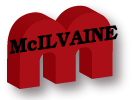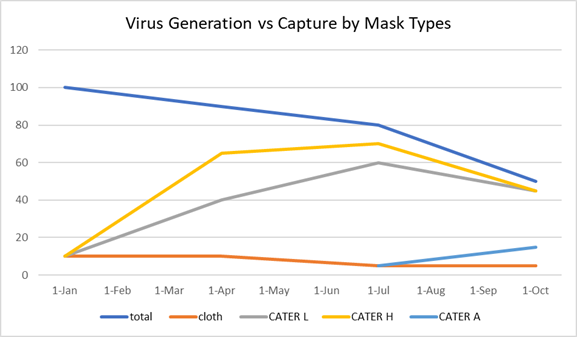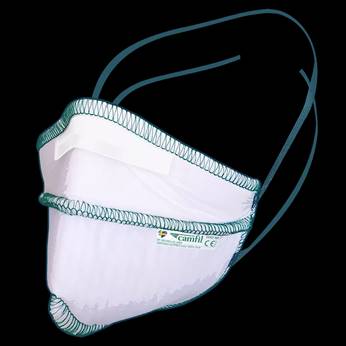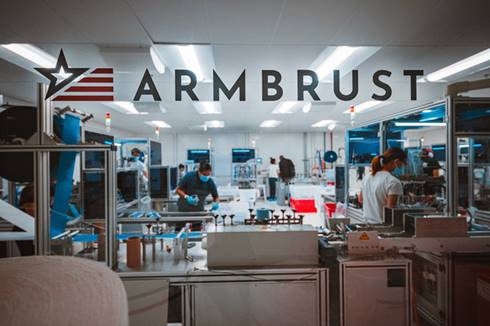
CATER Mask
Decisions
December 22, 2020
CATER 95 Masks can
Save Many Lives in the Next Nine Months
Can Camfil be a
Producer of CATER 95 Masks to Meet the Huge
Need?
Armbrust American
Receives ASTM Level 3 Rating for Its Masks
New COVID Bill Includes Funds to Improve School
Ventilation
________________________________________________________________________
CATER 95 Masks can
Save Many Lives in the Next Nine Months
Vaccinations are likely to reduce virus
transmission by over
40% in the next nine months. But many
lives will still be lost. CATER masks can be a
big contributor to reducing these losses.
the impact will depend on how quickly
they can be made available. Two scenarios based
on a low and high estimate of how quickly
production can be increased are shown in the
graph.
In either case CATER 95 masks will save
hundreds of thousands of
lives which might otherwise be lost in
the period.

·
Total = virus
transmitted. This decreases as vaccinations take
effect
·
Cloth =
virus eliminated by inefficient loose
fitting masks
·
CATER L = virus
eliminated with minimum ramp up of CATER 95
production
·
CATER H = virus
eliminated with maximum ramp up of CATER 95
production
·
CATER A = increased
CATER 95 sales for air pollution, health and
wildfire protection
Under this scenario CATER masks make a big
contribution to COVID mitigation in the next
nine months. Suppliers then divert part of the
production to other air contamination reduction
needs. Total CATER mask production would be
modestly lower in the July-December period but
sales would steadily increase in 2022 to
meet the large non COVID needs.
Can Camfil be a Producer of CATER 95 Masks to
Meet the Huge Need?
Camfil seems to have the capability to quickly
make enough CATER 95 masks to help meet the
urgent needs McIlvaine projects for the next
nine months.
In March 2020, Camfil started helping the
healthcare community by manufacturing and
testing respiratory protection. The hospital
environment is one of the core competence areas
for Camfil. They have successfully delivered
filter and ventilation solutions to various
hospitals and care facilities around the globe
in the past many decades including operating
theaters, laboratories, reception rooms,
intensive care units, and pharmacies.
Camfil has delivered CamProtect respiratory
protection, primarily to the Stockholm Region
along with other institutions in the healthcare.
The product CamProtect is now CE-certified by
Force Certification A/S. Initial production was
100,000 masks per week.

The idea for a mask took shape within Camfil
when the corona outbreak first emerged. As
experts in air filtration solutions, ideas for
respiratory protection masks began to come in
from Camfil offices in Malaysia, Spain,
Slovakia, Sweden, and others. The project then
gained momentum through Camfil’s Global Tech
Center in Trosa, Sweden with other areas of the
Swedish organization. Since respiratory
protection is not part of Camfil’s regular
manufacturing output, Camfil kicked off a
large-scale internal initiative to get up and
running with a prototype. Experts from product
development, testing, materials, purchasing, and
production participated. The prototype was then
tested in one of
the laboratories.
Product development in the filter industry
usually takes several months or even years. For
this fast pace development, it took plenty of
hard work to redeploy production lines while
finding partners and suppliers who could help
make the idea a reality as soon as possible. The
production started in Trosa, Sweden, and
CamProtect respiratory protection masks became a
reality. That was the beginning of the product
CamProtect.
There is now a huge opportunity for CATER 95
masks. The question is whether Camfil has the
interest and capability to provide this reusable
type mask on the same accelerated basis that it
achieved with the disposable mask
Armbrust American Receives ASTM Level 3 Rating
for Its Masks
With the country still in dire need of personal
protective equipment during the pandemic, U.S.
manufacturing startup Armbrust American
announced that its entire line of disposable
surgical masks has received an ASTM Level 3
rating, the highest rating for filtration
effectiveness available in the world.
Additionally, the company has opened pre-orders
for N95 respirator masks, as well as implemented
updates to its surgical masks.

Armbrust American's Texas-based medical mask
production facility.
An alarming number of disposable face mask
products available to consumers do not actually
provide the level of filtration required to
protect against the novel coronavirus, which is
why having both ASTM Level 3 rating and being
FDA listed are so important. Obtaining a Level 3
rating means Armbrust American masks have passed
performance tests for fluid penetration,
bacterial filtration, flammability, blood
spatter filtration, and breathability. Testing
was performed by Nelson Laboratories LLC and
done in compliance with the FDA's Good
Laboratory Practices (GLP) regulations.
"The key difference between Armbrust
American masks and what you'll find on retail
shelves is a promise that you're buying the
safest surgical masks in the world," said
Founder and CEO Lloyd Armbrust. "You're also
buying from a trusted and reliable manufacturer
that's constantly making improvements to its
products, unlike established competitors who
have little financial incentive and don't sell
directly to American citizens like we do."
Six months after launching its first factory, Armbrust
American continues to demonstrate that
commitment to innovation. The latest example is
an upgrade to add a newly developed secure-fit
nose bridge to its surgical masks, allowing the
wearer to create a more secure seal around the
face. The company also recently activated its
first line of N95 Respirator masks, which are
now available for pre-order.
New COVID Bill Includes Funds to Improve School
Ventilation
The $900 billion COVID-19
stimulus deal approved by Congress
includes billions for elementary and secondary
schools, including dollars to help with
improving ventilation and air quality during the
pandemic.
A total of $54.3 billion has been secured for
the Elementary and Secondary School Emergency
Relief Fund. This will send formula funding to
states and school districts so they can respond
to the coronavirus crisis.
Those dollars can be used for school facilities
repairs and improvements, like heating,
ventilation, and air conditioning systems
projects to improve indoor air quality, as well
as addressing learning loss among students,
including low-income students, children with
disabilities, English learners, racial and
ethnic minorities, students experiencing
homelessness and children and youth in foster
care.
Like schools across the country, districts in Massachusetts have been working to improve HVAC systems so students can safely learn in classrooms. In Worcester, city officials continue to work on a $15 million project to upgrade both school and city air systems. Students in the district, which is the second-largest in Massachusetts, remain in remote learning.
In total, Worcester has as of last week received
more than $39 million in funding to address
COVID-19 in the community, according to city
documents. Of that funding, about $23 million
was provided for city use and $16 million is for
the Worcester Public Schools.
Though, those dollars do not include what
Worcester anticipates to receive through the
Federal Emergency Management Agency Public
Assistance Program. Funding through that program
does not have a limit on the total amount
Worcester is eligible to receive but will
provide 75% funding for eligible costs. The city
administration is working with a
Massachusetts-sponsored consultant to prepare
and submit eligible expenses for reimbursement.
So far, the city has incurred about $2.3 million
in expenses officials believe will be eligible
for reimbursement.
Worcester plans to complement FEMA PA funds with
the Coronavirus Relief Fund Municipal Program (CvRF-MP)
funding, through the Massachusetts Executive
Office of Administration and Finance, to provide
the required 25% match. Those CvRF-MP funds will
also be used for expenses related to COVID-19
that were accounted for in the annual budget and
that are not eligible under the FEMA PA. The
largest project in that category is the HVAC
upgrade project, according to city documents.
All expenses incurred before Dec. 30 for that
HVAC project will be applied to the CvRF-MP
grant, except for $1 million, which will be
funded through one of the Worcester Public
Schools grants, according to the documents.
Earlier this month, as the Northampton Public
Schools worked to transition from fully remote
to hybrid learning, officials said the district
had purchased 385 high-efficiency particulate
air (HEPA) air filters for classrooms and
installed more than a dozen MERV filters in
school HVAC systems. More
than $200,000 was spent to
upgrade the air filtration systems.
In the federal relief package, billions of
dollars are slated for other educational needs
beyond helping schools with facilities repairs
and improvements. In addition to the $600 direct
checks, which will arrive
to Americans within weeks,
the deal includes enhanced federal jobless
payments of $300 weekly until the spring,
hundreds of billions of dollars in small
business loans, and aid to health care
facilities as vaccines are distributed.
